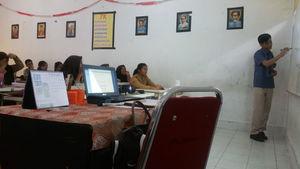The Indonesian Way of Teaching
- Rogel John Naval

- Feb 13, 2018
- 2 min read
Getting up early in the morning, the question on my mind was, "How different is teaching in Indonesia from teaching in the Philippines?"
To answer a smaller question on what language they use, definitely, the answer was so obvious -- they use Indonesian. To my amazement, everything was in Bahasa Indonesia. Even the mathematical terms were in Indonesian. I said to myself, "Wow! If this is possible, this is also possible for the Philippines! Maybe this way, our students would have a greater appreciation for mathematics." I borrowed the main reference Sir Affandi uses to teach the class, and as expected, it was in Bahasa Indonesia. The book, the students have copies of these, too, gives contextualized discussions to the students. Since it is written in Bahasa Indonesia, the students would easily understand it. On the board, although illegible, the writings on the whiteboard is the topic for the day (proportion, if I remember correctly), and the discussion. It is also written in Bahasa Indonesia.

Even if I couldn't understand most of what he said during that day, by observation, my mentor follows a traditional way of teaching -- lecture then drills. His medium of instruction is in Indonesian, even the drills he gave was written in Indonesian. He would lecture for about 20 minutes on the topic, then give the rest of the time for the drills. Before the time ends, he would ask students to present their solutions on the board and ask other students to comment if the solution and the answer is correct. If another student has an alternative solution, he would ask them to present it on the board as well.
During the period, my mentor uses a variety of formative assessment techniques. Often, as he administers the drills, he would come to each group and assist them especially on what the students feel is difficult for them. He would probe by breaking it down into simpler terms for the students so that they could get it and proceed to solving the problem.
What I learned from my observation on pedagogy is that maybe the best way to learn is through the first language of the learner. We are in the 21st Century. In the Philippines, although we give importance to English as our second language, we should remember our first language, Filipino. Do not forget about the local language as well that the learner is accustomed with. In my teaching experience before the SeaTeacher program, what I would say in English is emphasized using Filipino or Bikol. During my classroom observations with Sir Affandi, he uses Bahasa Indonesia all throughout the period in order to easily express and emphasize points of the lesson. After all, we are after the learning of the students, not the bragging rights that we speak English fluently in our classes. That is the most important goal of teaching -- learning.
So, to answer my question, the Indonesian way of teaching is, indeed, Indonesian.






Comments